Marcia Thornton Jones's Blog, page 37
February 8, 2023
PURIFYING MY PROSE -- by Jane Kelley
I think the Roman God Februus must have been an editor.
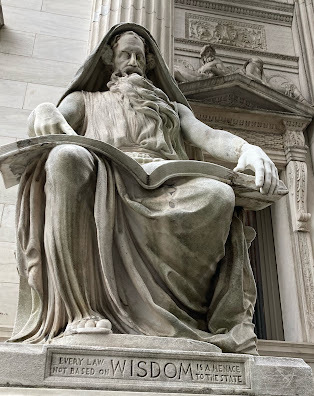
I'm not talking about my actual editors. They've always been kind and generous. This guy represents the one inside me. The stern task master who is pointing out yet another misguided word, or sentence, or paragraph -- or entire chapter.
According to Ovid, the ancestors believed that every sin and cause of evil could be erased by performing rites of purification in February. Most of my sins are found within the pages I'm writing. Let's hope Ovid is right.
What is demanded of me?
Cleaning -- This is needed on so many levels! First I must get rid of clutter. Throw away that scene where the Protagonist gets bullied. That adds nothing to the story. Wash away each trope and repetition. Scrub away the dirt of dull descriptions.
Salting -- (I had to look up what this meant.) Long before the time of Ovid's ancestors, salt was used to draw out the impurities. Much like how my mother told me to gargle with salt water when I had a sore throat. I need to get rid of those labels that shouldn't be used. Those poisonous thoughts––when one character is unnecessarily cruel to another or to themself.
Cutting a branch from a pure tree to wreath the priests' holy brows -- Well, I don't know whether I can find a priest with a holy brow. But I can come up with fresh, new ideas. I can cut the branch without killing the tree. I'm going to need it to keep supplying new ideas in the months to come.
According to Ovid, when February comes, the days devoted to the dead are over. Forget about those darlings you have killed. My current WIP has filled cemeteries. Don't mourn those who have been left behind. Look to the future.
I have forgotten to mention one thing I must do. Burning. Not in a destructive way. Light a fire to get rid of dead wood and debris. To provide the right amount of heat and light. To keep the passion that writing demands.

JANE KELLEY is a novelist, a fire builder, and a cleaner (more often of her writing than her house).
February 5, 2023
Interview with Mark Leiknes, author of Quest Kids
Welcome, Mark! Short and sweet: give us the elevator pitch for Quest Kids.
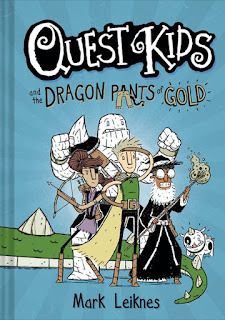
Thank you for having me on Smack Dab in the Middle! It’s an honor!
Quest Kids focuses on a group of children living in the middle ages who dabble in the quest-for-hire business. Only they’re not all that successful at it, because folks are reluctant to employ a bunch of eleven-year-olds to handle their sensitive questing needs. Sure, the Quest Kids have attempted a few quests but they can’t quite seem to complete a single one. However, they are sure that this will all change once they obtain a giant golden-fleeced track jacket to pair with a fiery dragon’s golden lounging pants. This will appease said dragon and keep him from burning down an entire mountain village. Okay, I think I could have said all that in one elevator ride, and without having to hold the “door close” button for too long :)
I’m always fascinated by author / illustrators. Tell us a bit about your background, and how you came to write for kids.
I’ve always loved drawing and my ultimate goal was to draw comics for a living. I ended up authoring the syndicated comic strip Cow & Boy for a few years. But it was hard to maintain a foothold on a shrinking newspaper comics page. And, sadly, kids just weren’t reading comics in the papers anymore. What they were reading, though, were comics in the form of graphic novels and books like Dog Man and Diary of a Wimpy Kid, so that’s where my focus went. As much as I loved doing a four panel comic strip every day, I found crafting an entire book to be so much more fulfilling.
How does a story come together for you? Visually first? Do you brainstorm in sketches or words?
Stories mostly unfold as I write. I will get ideas from a dream, or while driving, or just living my daily life. I will jot those ideas down and doodle a little bit in my sketchbook. These ideas become my jumping off point. Then I just sort of let the characters take over and they tell me where the story should go. I don’t really outline or have too strong of a notion where it all should end up. I like to surprise myself and discover things along the way. I figure if I don’t see it coming, then hopefully the reader will be taken off guard as well.
The illustrations in this book don’t just highlight something from the text–they actually drive the action. The book includes what I'd call comic book sections with action or dialogue panels. How do you balance the two elements? Or do they flow naturally?
A few things can determine when an illustration is needed. My rule is: If a character is speaking, then that can only happen in an illustration. If there’s action, I try to always show that as a visual or likely as a series of comic panels. If an illustration backs up or undercuts the prose in a humorous way, I will do my best to make it happen. As a general rule, I try to work in some bit of imagery on every page.
I’m also a sucker for a good tale with humor–boulders that sweat, death nuggets, recently dragon-roasted highly skilled knights. I imagine this book was a blast to put together. But I do know how hard comedic writing can be! Was this a blast, or was it hard work?
It’s probably more difficult for me to write in a dramatic tone. I think my voice has always skewed towards humor; that feels the most natural to me. I was sort of the “funny one” of our friend group. That being said, authoring a book is an incredible amount of work. I feel like it’s in aconstant state of revision until the publisher pries it from my hands and tells me we have to print. I do love the process, though, and I feel very much like I was built to write these particular books.
We rarely get to talk to illustrators: What’s your drawing process like? Can you give us some insight? What programs do you use, etc?
It all starts in the sketch book. I do a little thumbnail or super rough sketch of how I want a page to look. Then I sketch the illustration full size. I scan that sketch and then “ink” it in the computer using my Wacom tablet and Adobe Illustrator. After that, I import everything into Photoshop where I add some texture and shading. Then I step-and-repeat this process for about 300-ish pages :)
The MG voice in Quest Kids is just spot-on. How do you get the right frame of mind to tap into that voice?
Writing the book in the first person really helps. It sort of puts me in the mindset of Ned pretty quickly. I actually find it more freeing to write as if I AM a character. I performed improv a while back and I always found it easier to come up with things to say if I was really in character. Maybe writing as someone else makes you lose yourself a bit and you’re less worried about whether the audience is judging you or not.
This book is just tailor-made for reluctant readers. It’s got so much visually happening for it–and it’s such a nice, thick book, too. It’s got to give young readers who don’t come to books naturally a real feeling of accomplishment reading this! Were you a big reader as a kid yourself?
I wouldn’t say I was a huge reader growing up. I definitely read a lot of comics, though. I’ve always been attracted to their visuals and tried to emulate them in my own drawings. I do think that the thick blocks of text in books can be intimidating for young readers just starting out. I know they were for me. Breaking up prosewith a lot of imagery really helps reluctant readers not get overwhelmed. Kids can complete chapters a little easier and feel a sense of accomplishment, like you mentioned. I used to design magazine layouts and was always very conscious of breaking up that body copy so the reader wouldn’t get fatigued. Quest Kids is a bit of an extension of that, while also owing a lot to Wimpy Kid’s comics/prose format.
What do you hope young readers take from Quest Kids?
I just hope kids laugh and have a good time. And maybe they get inspired to write and draw their own stories. Alongside reading a good book, I’ve never regretted my own time spent writing and drawing. It’s all helped enrich my life in so many ways. I don’t really go into a book thinking about a theme or message. Those always sort of reveal themselves to me when I’m finished. This book seems to be about staying true to who you are and being upfront with the loved ones around you. Also, there’s a bit about perseverance and overcoming adversity, so I guess those are all good things for young people to take away.
What’s next?
More Quest Kids! I’m finishing up the second installment right now, which will be out in the fall. Quest Kids and the Dark Prophecy of Doug is the working title. Then there will be a third Quest Kids out the following year. Not sure, what lies beyond that, but it’s way more than enough to keep me busy for right now :)
~
Be sure to keep up with Mark Leiknes at his author site, and order your own copy of Quest Kids.
February 4, 2023
Salt Marsh Musings (Guest Post from Kimberly Behre Kenna, author of Artemis Sparke and the Sound Seekers Brigade)
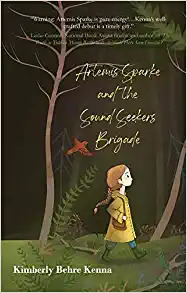
It was a fall day like any other as I hiked the trails around a salt marsh not far from my Connecticut home. Leaves on the trees were just beginning to turn, and the air had a bit of a prickle to it. But that’s where ordinary ended, because halfway up the steep hill that would provide me with my favorite view of the salt marsh, something extraordinary happened.
A girl named Artemis whispered her story in my ear. I’d never met her before, but she felt familiar, and I was eager to listen. Over time and many revisions later, her story became my debut middle-grade novel, Artemis Sparke and the Sound Seekers Brigade.
I’d begun writing full time by then, so I was open and ready for a character like Artemis to arrive on that fall day. Though her appearance surprised me, it made sense. For many years, I brought my fifth-grade students to this salt marsh as part of our study of the ecology of Long Island Sound. On every visit, I witnessed changes in my students. While observing osprey through a pair of binoculars or watching fiddler crabs burrow at low tide, the quietest children became animated and chatty, and the most outgoing became silent with awe. I could relate. As a shy child myself, I found solace and invigorating delight in my shoreline explorations, and that experience continues to this day.
My mind was fertile for Artemis’s story. It had been seeded by my days with my students. To begin our Long Island Sound studies, we’d read picture book biographies of ecologists. From there, each child chose one ecologist, analyzed what they knew about them, and applied that knowledge to try to solve a current problem around Long Island Sound. How might we use the past to better understand the present? If George Washington Carver were alive, could his ideas about soil conservation help sustain salt marsh plants against the rising tides? Could the strategies Chico Mendes used to help save the Brazilian rainforests also help save our shoreline? To find out, we resurrected their ghosts, and these proved to be fascinating (and educational!) encounters.
Children stepped into the shoes of their ecologist and wrote persuasive monologues about activism from their point of view, took part in roundtable discussions brainstorming how to use teamwork to address pollution in Long Island Sound, and wrote and performed plays where deceased ecologists came to the aid of humans challenged by problems in nature.
So, it was no surprise that as the seeds of Artemis’s story sprouted, some of them took on an uncanny resemblance to real life. Artemis is a girl who stutters and finds sanctuary in the peaceful salt marsh, then becomes heartbroken when she witnesses its decline. Unable to drum up enough support from humans, she conjures up the ghosts of deceased ecologists for help. Thanks to their knowledge and the resilience modeled by the creatures and plants of the salt marsh, Artemis’s whisper becomes a calling as she embraces her voice and encourages others to join her brigade to save the salt marsh.
All of my middle grade books were inspired by my life as a teacher as well as my own experiences as a child. I learned that no matter how ordinary a day may seem, if you stay open and on the lookout, magic is bound to happen. And it usually starts as a whisper.
~
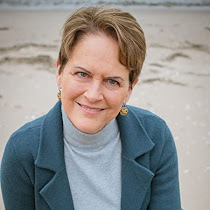
After years as an adolescent and family counselor, and then as a fifth grade teacher of ecology and language arts, Kimberly returned to school for her MA in creative writing from Wilkes University. Her middle-grade novel, “Artemis Sparke and the Sound Seekers Brigade” was a finalist and received Honorable Mention in the 2019 Tassy Walden New Voices in Children’s Literature Competition. It will be published by Fitzroy Books 2/2/23. Another book in her Brave Girl Collection, “Jett Jamison and the Secret Storm” is forthcoming from Black Rose Publishing 8/3/23. A third in the collection, as yet unpublished, won second place in The Institute of Children’s Literature 2022 MG Mystery First Pages Contest. Her poems and short stories have been published in American Writers Review, Mused, Plumtree Tavern, and Rubbertop Review. Her full-length play, “Ana’s Hummingbird,” was given a staged reading at The Dramatists Guild in NYC. She’s a member of SCBWI and PEN America, and now devotes herself to writing full time. Connect with her at www.kimberlybehrekenna.com
February 3, 2023
On Time, Sacrifices, and Difficult Choices in the Writing Life
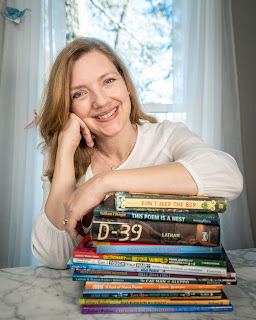 Hi, Irene Latham here. Happy February! The shortest month seems like as good a time as any to talk time, sacrifices, and difficult choices.
Hi, Irene Latham here. Happy February! The shortest month seems like as good a time as any to talk time, sacrifices, and difficult choices.The truth is, anything that requires as much time as writing is going to mean sacrifices.
I'm not a big fan of that word “sacrifice,” though, and prefer to think of it as making a choice. It's a decision.
Anytime we choose to do anything, we are choosing NOT to do something else. So, occasionally (okay, maybe more than occasionally) I've had to make difficult choices.
Like giving up SLEEP. When I first started writing to get published, our children were very young, and the only extended more-than-15-minute-snatch of time I could guarantee myself was in the early morning hours before the kids were awake. I have spent many a dark-everyone-still-sleeping hour writing!
Another daily sacrifice is TV. Paul and I love to watch TV together, but I can't give my whole evening to it. I usually cut out early, so I can get in another hour or so of writing/reading time.
But the most difficult choices have been the ones that mean I can't be in two places at once. One of the most fulfilling parts of being an author is sharing the experience with others via school visits, book festival, conferences, retreats, and travel. Some of the best moments in my life have come from participating in such events! And yes, I need the community, and I owe it to my books to promote them, but DANG. I hate missing any time with the people I love best. Family events, occasions, every day fun... you can't get those moments back, you know? (Most recently I missed taking our son to the airport before a 3 week stint in India, because I had a book event the same day. I made up for it by being there to pick him up the night he returned...WAY past my bedtime. :)
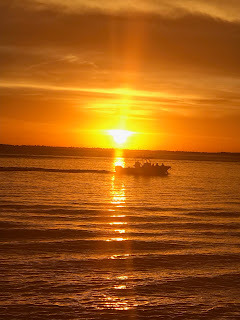 Last month I carved out 2 whole
Last month I carved out 2 wholeweeks with no book events/ school visits
for a trip to the FL Keys!
Which is why these days I am hyperaware of TIME as our most valuable resource. Our kids are grown, and I can write uninterrupted during the daylight hours. I am committed to not overdoing, overbooking, over anything. I take social media breaks and do my best to prioritize family time and vacations over book events. This takes effort and planning! Sometimes despite my best efforts, I still can't be in two places at once. But I don't beat myself up about it nearly as much as I used to.
I see this evolution as sort of the life cycle of a creative. Of course when we start out, we're much more willing to do All the Things. Now that I'm more established, I understand how little control I actually have over any of my books' success. I've enjoyed many wonderful, meaningful experiences. I can now, with much less angst, “sacrifice” some of the author-life opportunities and choose family, quiet, peace of mind.
What I can't live without, what I choose over and over again, is the actual writing. Every day, here I am, tapping away at my computer. Paul and the rest of my family support me 100%. They let me be me, and they always welcome me when I come out of the cave. I'm so grateful. 💗
February 2, 2023
Some Thoughts from MG Writers
Over the past month, I’ve had the pleasure of interviewing (on my other blog, Book Q&As with Deborah Kalb) several middle grade authors about their wonderful new novels, and I decided to share some of their thoughts here…
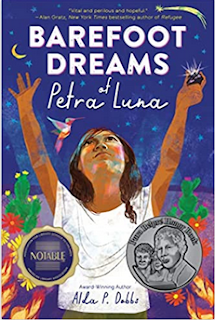
Alda P. Dobbs is the author of the new MG historical novel Barefoot Dreams of Petra Luna , which was inspired by family stories. “The topic of people escaping violence in their homeland and coming to the U.S. for safety is as prevalent today as it was back in 1913 when Petra and her family escape her village,” she said. “It’s important that we, and especially young readers, realize the importance of family stories, and how through them we can see how history repeats itself.”
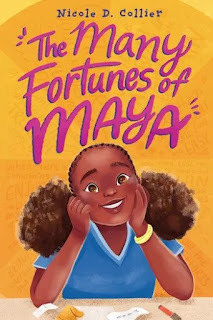
Nicole D. Collier’s new MG novel, The Many Fortunes of Maya , focuses on a girl whose parents are having marital troubles. “Growing up I was a certified Daddy’s girl,” Collier said. “I definitely loved my mother, but the relationship Daddy and I shared was special. At one point in elementary school, my parents’ relationship deteriorated and they decided a trial separation was in order. It didn’t last long (two weeks), but I really missed him and was very happy when he came back home. I wanted to write a story grounded in that moment.”

Martha Freeman is the author of the new MG novel Trashed! . It centers on a boy who helps out at his family’s junk store. “For a long time I’ve been interested in people’s relationships with their stuff,” Freeman told me. “I think the urge to acquire is inherited from hunter-gatherer ancestors who had to collect or perish. That urge is doing the planet more harm than good these days, and yet our whole capitalist system is based on it. A conundrum! I think one place a person can revel guilt-free in the wonder and variety of stuff - and even satisfy that acquisitive urge - is at a ‘junk store’ like Universal Trash.”

Joan Holub’s new books include the latest in her MG Goddess Girls series, Artemis the Hero . Holub said of the series: “Goddess Girls fans are great about suggesting which goddesses they’d like to read about, and we listen to their requests. Artemis the Hero is book 28 in the series, and we’ve got the next two books in the works. (Goddess Girlsbegan as a four-book series, so Suzanne and I chose our four favorite goddesses--Athena, Persephone, Aphrodite, and Artemis--and wrote one book about each of them.)”
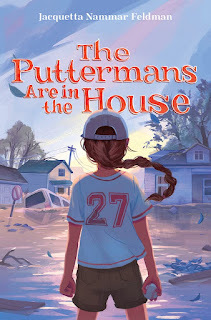
And Jacquetta Nammar Feldman’s new MG novel, The Puttermans Are in the House , focuses on a family in Houston during Hurricane Harvey in 2017. “At the heart of it, this is a story about the change and growth that can happen during times of upheaval and adversity and how family members might rise in love and support of one another,” she told me. “Though this story revolves around a hurricane, we’ve all seen in recent times how other hard circumstances can bring us together.
--Deborah Kalb
@font-face {font-family:"Cambria Math"; panose-1:2 4 5 3 5 4 6 3 2 4; mso-font-charset:0; mso-generic-font-family:roman; mso-font-pitch:variable; mso-font-signature:-536870145 1107305727 0 0 415 0;}@font-face {font-family:Calibri; panose-1:2 15 5 2 2 2 4 3 2 4; mso-font-charset:0; mso-generic-font-family:swiss; mso-font-pitch:variable; mso-font-signature:-536859905 -1073732485 9 0 511 0;}p.MsoNormal, li.MsoNormal, div.MsoNormal {mso-style-unhide:no; mso-style-qformat:yes; mso-style-parent:""; margin:0in; mso-pagination:widow-orphan; font-size:16.0pt; font-family:"Times New Roman",serif; mso-fareast-font-family:Calibri; mso-fareast-theme-font:minor-latin;}.MsoChpDefault {mso-style-type:export-only; mso-default-props:yes; font-size:16.0pt; mso-ansi-font-size:16.0pt; mso-bidi-font-size:16.0pt; mso-fareast-font-family:Calibri; mso-fareast-theme-font:minor-latin;}div.WordSection1 {page:WordSection1;}
January 30, 2023
My Own Gatekeeper (Holly Schindler)
I've bumped into several posts this week about restrictions on reading--my state of Missouri has decided it's a class A misdemeanor if anyone provides visually explicit sexual content to a minor, which means books are disappearing from the shelves.
It's made me think about my own first gatekeeper--my mom.
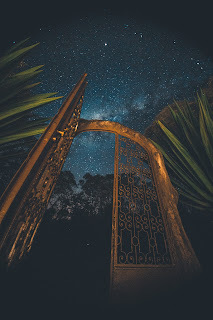
With Mom, it wasn't just that the door on that gate was open. At times, I'm not sure there was ever even a gate at all.
If I wanted to read it or see it or listen to it, that was fine. She watched where my interests were, and fed into it. I remember her bringing home Picnic after I'd watched Dirty Dancing (at 11), telling me the scene in which Kim Novak danced down the steps was kind of the talk of the town when it released. And in that way, she introduced me to William Inge.
And so on.
It wasn't just what was--titillating, though. It was anything. I listened to metal and to Sam Cooke. I saw musicals. I am, to this day, a classic movies nut. I read and read and read...
And I learned, in all of that, to appreciate all sorts of different ideas and sounds and ways of telling a story. I learned that people had experiences like my own and wildly unlike my own.
Really, I think, an open gate helps a young person develop an open mind.
And that may be the thing for which I'm most grateful.
January 28, 2023
Who Appointed YOU as Gatekeeper?
By Charlotte Bennardo
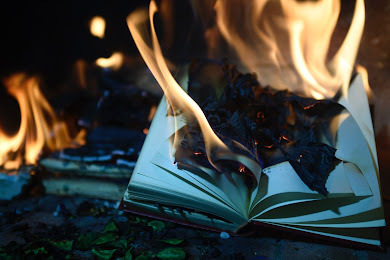 Photo by Movidagrafica Barcelona (Pexels)
Photo by Movidagrafica Barcelona (Pexels)As an author and former journalist, the increasing calls for 'overseeing' (gatekeeping) what reading materials are acceptable in public school and classroom libraries is nothing more than censorship, of one group trying to impose their standards, thus their will, on everyone else.
Don't want your child, who may be questioning their sexuality reading about a gay teen, such as in "Two Boys Kissing" by David Leviathan? Don't want your child reading about an interfaith family, puberty, and a girl's first period like in "Dear God, It's Me, Margaret" by Judy Blume? That book has been out since 1970- you've had plenty of time to deal with it. So honey, your issues are way deeper than your child reading one of these books; the issues are with YOU, and what YOU want. What YOU believe. Violent movies and video games are okay, BUT certain books...
If your child brings home a book you don't 'approve' of, sit down with them and discuss why they want to read it. Maybe they're just curious, maybe they feel like they are the same as the character, maybe a friend suggested it to them for whatever reason. This is an opportunity to get on a more personal level with your child, really learn about them. Read the book together, discuss it. Tell them what specifically makes YOU uncomfortable or even angry. Give your child the same opportunity to understand it.
I liken this situation to my husband's Italian family at dinner. Children aged 13 or so were allowed a sip of wine with dinner. They hated the taste- but the mystery was solved- what does wine taste like? And because that mystery was solved, they didn't sneak liquor behind their parents' backs; it was a shared experience. It gave them a context that generally held throughout their lives; they rarely abused alcohol.
Remember....
“Censorship is the child of fear and the father of ignorance.”—Laurie Halse Anderson, Speak
— Stephen King
— Judy Blume
For more quotes on banning books and the idiocy behind it, go https://www.bustle.com/articles/183209-15-quotes-about-censorship-and-the-danger-of-banning-books
Charlotte writes MG, YA, NA, and adult novels in sci fi, fantasy, contemporary, and paranormal genres. She is the author of the award-winning middle grade Evolution Revolution trilogy, Simple Machines, Simple Plans, and Simple Lessons. She co-authored the YA novels Blonde OPS, Sirenz, and Sirenz Back in Fashion. She has two short stories in the Beware the Little White Rabbit (Alice through the Wormhole) and Scare Me to Sleep (Faces in the Wood) anthologies. Currently she is working on several novels for both children and adults, and her MFA. She lives in NJ with her family and her floofy cat. When they trimmed the backyard tree, the crazy squirrel couple had to move out.
January 26, 2023
Let’s (Not) Panic Like It’s 1999: How Doomsday Dani Came to Be - Carissa Turpin
 In many ways, the protagonist of my middle grade novel, Dani Collier, is a normal tween girl. She attends middle school, which she finds dull and unimportant. She likes to draw, play video games, and bicker with her little sister. There’s one characteristic, however, that sets her apart: it’s 1999, and Dani is a doomsday prepper obsessed with the forecasted Y2K disaster.
In many ways, the protagonist of my middle grade novel, Dani Collier, is a normal tween girl. She attends middle school, which she finds dull and unimportant. She likes to draw, play video games, and bicker with her little sister. There’s one characteristic, however, that sets her apart: it’s 1999, and Dani is a doomsday prepper obsessed with the forecasted Y2K disaster. Like most ideas that germinate in my brain, Dani was inspired by my students. In 2019, I was working as a language arts teacher at McKemy Academy of International Studies in Tempe, Arizona. It was the final day of school before holiday break, the bell signaling dismissal had already chimed, and a few students were lingering in my classroom and saying their goodbyes.
“It’s going to be so weird seeing the last two digits of the calendar change,” one student said to another.
“Can you imagine what it was like going from 1999 to 2000?” the second student remarked.
Like most elder millennials, I can remember where I was on New Year’s Eve 1999 with surprising clarity, so I couldn’t help piping up.
“We thought the world was going to end,” I said.
When they turned to me wearing baffled expressions, I hurried to clarify. I stumbled through an explanation about computer glitches and a song by The Artist Formerly Known as Prince, but it was clear this was their first time hearing about Y2K. In their world, technology was infallible. Every device in their life—from their smartwatches to their cell phones to the electronic assistants like Alexa that sat in their kitchens—updated automatically and flawlessly. It was difficult for them to imagine a world where this wasn’t the case. As for me, I noted that this was a period in history that middle schoolers knew little about and thought it would make for a good book. I jotted the idea down at home and quickly forgot about it.
Then, in March of 2020, the world turned upside down.
I can remember my inbox filling with panicked emails from students—they can’t shut down school, can they? I was the adult tasked with reassuring them, but, in truth, between refreshing the homepage of the CDC and wiping down my groceries with a Clorox wipe, I was looking for an adult to reassure me.
It was then that I turned to writing, determined to flesh out my idea of a middle grade novel with a Y2K setting. There was something so comforting about being the author, about knowing that my protagonist would ultimately make it past all her worries unscathed. It gave me hope that my students and I could weather this storm, too.
Since the moment I finished writing it, I’ve believed that Doomsday Dani is a book that adults and kids can read together. While adults can bask in the Y2K nostalgia, kids and adults can learn some important lessons: the importance of verifying online sources and how to cope with hardships like bullying and divorce. I believe, too, that readers will finish the novel feeling a certain degree of hope. Like Dani, we are tough enough to endure uncertain times and we can look forward to better days ahead.
~
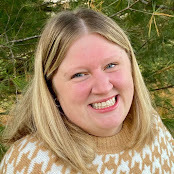
Be sure to keep up with Carissa at her author site, and pre-order a copy of Doomsday Dani here.
January 23, 2023
Keats IS Smack Dab in the Imagination, by Dia Calhoun
John Keats Letter to Benjamin Bailey November 22, 1817
Short post today. Recovering from Covid, I can say I am in agreement with the above.
January 19, 2023
My 2022 Favorite Book Recs
Happy 2023!
Another year wrapped in the books – with weeks full of reading books of every genre. I’ve selected my five top favorites in middle grade and young adult. They are not all novels released in 2022, but from a variety of years, and in no particular order. If you have room on your 2023 reading list, I hope you enjoy them as much as I did!
The Cats You Meet Along the Way by Nadia Mikail
It’s the end of the world. Seventeen-year-old Aisha hasn't seen her sister June for two years. With chaos looming and the end of times drawing near – maybe less than a year, Aisha and her mom reach for healing hearts in the troubled times and go find their kin. With Aisha’s boyfriend, Walter and his parents, and carryon Fleabag the Stray Cat, the van-full roadtrips through Malaysia in their artful campervan. It’s a time for reflection, release; time for small plans for the future wrapped in hope and acceptance. I found this to be a heart-echoing, moving and sweet family and loved ones story. Mikail’s debut hits with enough light-heart and soul at a dark time during an impossible time such as a full-on global apocalypse. I love books with cat antics!
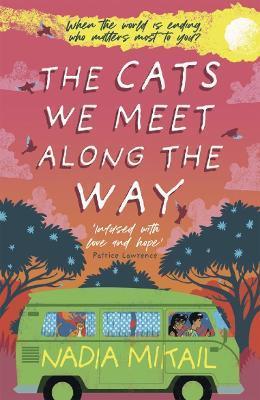
A Blue So Dark by Holly Schindler
Admittedly, I am already a Schindler fan. I often save some of her winter and Christmas-themed novels towards the end of the year. For 2023, I chose it as a time to pick up the much-anticipated A Blue So Dark. Compelling and beautiful, A Blue So Dark was beautiful and emotionally raw. All the complications and tensions of being a teenager are difficult enough without the hardships of needing to care for an adored parent. Aura, 15, faces something so few young adults have - a parent with mental illness. I found it deeply touching on this view of schizophrenia, as well as the relationships Aura has with her father, best friend and school, as well as a boy and grandmother. The impact it carries throughout were a complex psychological study that is both sad and beautifully deep. It is a stunning, emotionally raw book that is heartbreaking and beautiful all at once, I felt.

The Orphan of Salt Winds by Elizabeth Brooks
England, 1939. Virginia Wrathmell, age 10, walks into the gothic-beautiful house called Salt Winds. It’s a lonely, secluded house on the edge of a marsh. Here, Virgina will meet her adoptive parents as well as dependable Clem and mercurial Lorna. The marsh, with its moody and deceptive tides, makes for a stunning yet insecure and often threatening place. Virginia’s new parents’ are on walking wire tensions she doesn’t grasp, and their wealthy neighbor, Max, swings through far too much, taking an odd an unwarranted interest in the family. Still, Virginia begins to root in the old house, in the marsh and especially in Clem. She finds the true heartbeats and threads of “home.” The raging war feels far away marsh birds and wildlife, shifting tides and sands and thick understory. That is, until a German fighter plane goes down in the marsh. Brave, Clem heads to the mercy of the marsh to find and rescue the airman. A crime occurs – forever changing Virginia. Jumping ahead 75 years later, Virginia returns to the marsh only to recognize there her teenage self, still frozen in time from an unhealed and tragic past at Salt Winds. This was a beautiful and haunting read for me, one that led me to read more evocative work by the same author.
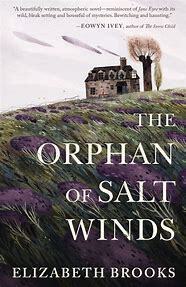
The Firekeeper’s Daughter by Angeline Boulley
Biracial, unenrolled tribal member and the outcome of a scandal, teen Daunis Fontaine has always felt split and found she never quite fit in - either in her hometown or on the nearby Ojibwe reservation. A family tragedy hits, and Daunis finds herself putting aside her dreams to care for her fragile mom. It’s a dark time for the teen, who finds a warm light of hope in meeting newcomer Jamie, a new player on her brother’s hockey team. From bad to worse, Daunis witnesses a shocking and life-changing murder. Suddenly, Daunis is entrenched in a criminal investigation. Personally, she vows to solve it. Even as more deaths occur and threats hit too close to home. Deep and emotionally-tugging, I found this novel to be both deep with a touch of humor and sarcasm that kept it engaging and light amid the dark actions Daunis encounters. Having lived a couple of miles from an Ojibwe reservation, I recognized a few youth I met – those that crossed the lines of both on and off reservation life, those who fought to spend their lives living their Native American roots for life on the reservation, and those who wanted to leave. I feel that Boulley is clearly a voice of these experiences and life. This was a unique and what I found an authentic look into life for a young life dedicated to all angles of her family and own self.

The Boy With the Bird in His Chest by Emme Lund
Young boy Owen Tanner is just that – a boy. Though he has never met anyone else who has a chatty little lady bird in their chest, he is entirely used to his chirppy friend, Gail. Medical professionals call him a Terror. When Owen’s mom sees Gail between her son’s ribs, she knows she must hide him and his bird from the misunderstanding world. Feeling stuck and confined, Owen spends more than a decade in hiding and secret with Gail. Perhaps that’s what drives him to dive into a risky trip into the outdoors where he meets a forest fire, causing his life to overturn and change forever. Owen must flee home and hide in the open eye with his uncle and cousin on the upper west coast. Despite the upending, Owen finds friends amid family, of finally being able to share Gail with others and finally, feel accepted as a person and an alleged Terror. There’s also the tribulations of life and young love, heartbreak and true joy. This was such a different and touching novel that made me feel both afraid, understanding of being isolated, and the spark of life breaking the lines and fully living a life not quite the norm.

Happy Reading!
A.M. Peaslee
(All images courtesy of Amazon.com)



